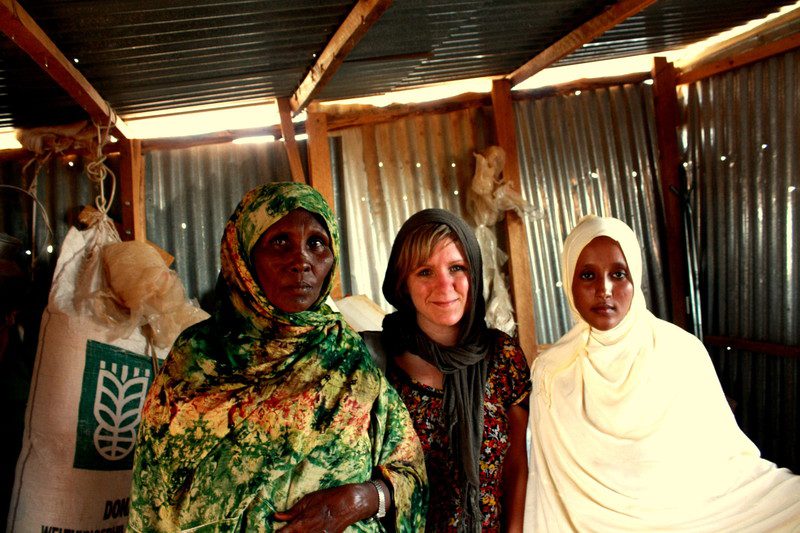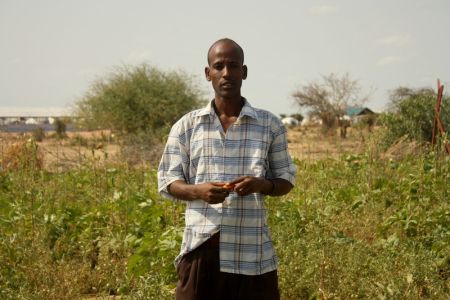
By Jo Harrison, Digital Press Officer, Oxfam GB
Recently, we published a blog post marking the one-year anniversary of the East Africa food crisis, featuring joyous photos of villagers from Turkana, Kenya, celebrating the installation of a water bore in their community. Now, we bring you a fascinating story by OGB’s Jo Harrison, who visited the Dadaab refugee camp one year after the emergency was declared.
Then and now
The last time I came to Dadaab was in July 2011. Famine had just been declared in Somalia and refugees were pouring into the camp at a rate of 1,500 people per day. People had walked for upwards of 30 days to reach the safety of Dadaab and were weak, malnourished and traumatised from the journey. It was not uncommon to meet mothers who had to make the difficult decision about which child to leave behind, or in many cases, who had to bury their young by the side of the road.
Arriving back to Dadaab almost one year later, driving around the camps, it is a visibly different scene. The animal carcasses are no longer littering the streets, there are leaves on the trees and the many thousands of makeshift huts made from twigs and plastic bags have been replaced with tents and in some cases brick houses. The once bustling site for registering new refugees is now a desolate wasteland.
Simple but life-saving
Oxfam has had the unglamorous task of installing water facilities and providing preventative health measures such as cleaning and installing toilets, showing people how to clean jerry cans and simple but life-saving training in personal hygiene. It may sound obvious, but to the nomad who has spent the majority of his or her life in the bush, the cultural importance of washing your hands or using a toilet can seem foreign and have a devastating impact when you then have to go to live in a crowded place. Oxfam are well known here. People have nothing but good things to report about the water facilities in camp; often repeating the phrase “water is life.” The open defection I witnessed last year is a thing of the past and people are no longer rolling their jerry cans on the floor. They are keeping clean and sharing their knowledge about germs between themselves.
But life in Dadaab is still far from good. As a refugee in Kenya, you are unable to work in the country. Some of the lucky ones have managed to set up their own business within the camp but many face long laborious days of doing nothing. The children who managed to get a place in one of the camp schools are educated until 16, but they have no prospects after completing their studies. Even the teachers are refugees, paid a tiny ‘incentive’ salary by various agencies. I met Mohamed Hassan Dirige, a secondary school teacher. He came to Dadaab in 1991 at age of five. When still in Somalia, terrorists lined him and his family up, bound their hands together and shot each person leaving them for dead. He earns 8000 KSH (about £64) per month. This must be shared with his entire family, leaving them with below 50p each per day to live on. He still receives food rations and would like nothing more than to return to his home country where he can earn a better wage.
Oxfam has been employing refugee ‘incentive workers’ wherever possible, to do work such as building latrines and teaching public health. Oxfam is also providing some refugees with tools, seeds and water to start their own small cooperative farms, like 27 year old Omar Abdullah. He grows tomatoes and potatoes which his family sells at the local market. He makes about 2000 KSH per week and has been able to build his family a brick house with his earnings. He hopes to expand the farm and within another year or two, be able to survive without food rations.

A tough and challenging environment
Security is one main concern for the refugees. After the abduction of two aid workers in October 2011, many of the vital services provided by the aid agencies had to cease operating and UNHCR were no longer allowed to register new arrivals. Although the security situation has now improved, it is far from safe for the workers operating in the camps. There are almost ‘daily’ reports of finding improvised explosive devices, which when found, often mean that the workers have to halt work.
It is a tough and challenging environment for everyone involved at Dadaab refugee camp. The people here are desperate to return home and do not want to live on handouts. But until peace in Somalia is secured, they have no choice but to wait in hope.
Until such time, Oxfam and other aid agencies are providing around 465,000 people with life-saving support including food, water and education in preparation for their return home.
Find out more
View “Dadaab life in pictures: Actors and millionaires“, a photo-gallery by Jo Harrison on www.bbc.co.uk
Learn more about Oxfam’s response in East Africa